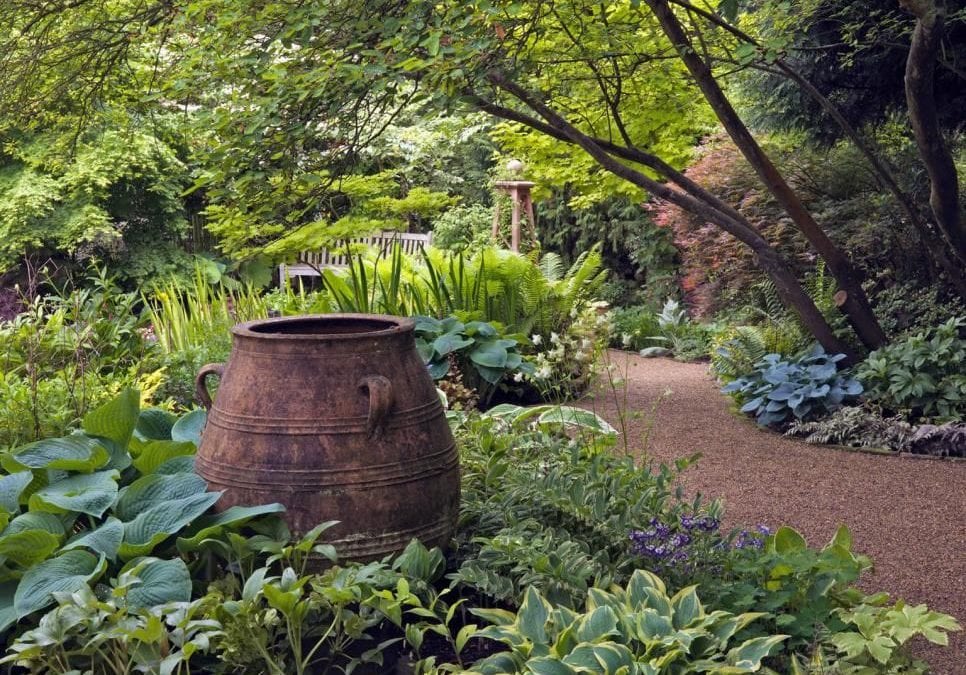Whenever I chance upon a shaded garden, it evokes such a feeling of calm and cool collectedness, even if the temperatures and humidity levels are soaring. Shade gardens, by their very nature, avoid the chaos and clutter experienced in sunny gardens. The more limited palette of shade tolerant plants can force you to commit to a simpler color scheme. This works to your advantage. In color therapy, green is used to soothe and relax people, mentally as well as physically. Green also helps those who are suffering from anxiety and nervousness. Designing a garden by using foliage can create positive effects on your psyche. And it is beautiful botanically.
And I’ve discovered, when designing annual containers that using a higher percentage of foliage plants in the garden can be just as showy and interesting as planting all flowering species. Foliage looks good all season long and there are no maintenance chores, like deadheading, that require constant monitoring. Shade garden designs need to rely more on combining the form, color and texture of plants, adding a smattering of flowering plants to enhance seasonal interest. Think of your shade garden as the opportunity to create a gentler type of outdoor room, totally different from your frenetic sunny flowers.
Just because there aren’t as many flowers on which to rely for pizzazz, doesn’t mean that a shade garden will not be colorful. In fact, just the opposite is true. The best-known, and probably most popular shade plant is the Hosta. These days, they come in a veritable riot of leaf colors, shapes and sizes. From screaming chartreuse to cool blue, Hostas are a workhorse in the shade garden. Don’t overlook them as flowering plants either. Some of the varieties with very large, fragrant flowers drive hummingbirds are crazy. Flower colors range from pure, sparkling white to soft purple, including some with stripes and streaks, and others with multiple rows of petals. The overall texture of Hostas is usually fairly coarse and chunky. Large, broad leaf shapes and thick substance give a bold feel to the design. They are great for anchoring a perennial shade garden and combine well with more finely-textured plants.
Ferns have come into their own, as a valuable perennial group. Years ago they were often accused of being boring, but there are so many varieties to work with now that they really deserve their own chapter in any gardening book. The native woodland species are always beautiful and useful in the shade garden, and many are more sun-tolerant than you would believe. Maidenhair Fern, Adiantum pedatum, is one of the most finely textured and delicate-looking plants you can imagine, but they are pretty tough. The vase-shaped Ostrich and Cinnamon Ferns are very architectural and can be used as a backdrop for large-leaved perennials. Ferns also have a great range of sizes from the squatty stance of the Deer Fern to the upright habit of Ostrich Fern. One of my favorites are the Japanese Painted Ferns, Athyrium niponicum ‘Pictum’. Their dramatic foliage color stands out in any garden. Keep in mind that Painted Ferns emerge very late in the spring, so don’t panic if you don’t see them right away.
Another of my favorite groups of shade perennials are the Snakeroots, or Actea. These plants are an outstanding addition to the textural interest of the garden with their ferny foliage and tall spires of tiny ball-shaped buds, which open to bottlebrush flower spikes. Some varieties have bronze or dark purple foliage and flowers of the palest pink imaginable. Snakeroots are useful as a backdrop, as some varieties attain a height of four to six feet. Flowering occurs from mid to late summer. Butterflies like the fragrant flowers and are often seen clinging to the spires as they wave in the late summer breezes
A shrub that I have had in every one of my gardens is the Bottlebrush Buckeye, Aesculus parviflora. Although this shrub is often unassuming at the garden center, once established in your yard becomes a real player. It grows to 8 to 10 feet high and wide, so give it a big space. As it matures, it will produce tons of creamy flowering spikes in late June and early July. And the butter yellow fall color lights up a shadowed corner.
The Witch Alders, or Fothergilla gardenii, are close relatives of our native Witchhazels. They share many of the same characteristics, like bottlebrush-shaped flowers in early spring and zigzagged stems that catch the winter snows. They really come into their own in the fall though, as the Witch Alder foliage turns intense shades of red, scarlet and orange.
Typically, shade plants like to be planted in rich, moist soil. But keep an eye out for slugs and earwigs as they are attracted to shady, moist places. They will make lunch of your prized perennials, and quite quickly. There are lots of home remedies and other stronger concoctions available at the garden centers to combat these critters if you have a need.
Shade gardening can be so much more than growing plants that bloom with less light. Plan yours so that it tickles all of your senses, stimulating the mind as well as the eye. These calm spaces are worth creating, if for nothing more than the play of light through leaves and the shadows of its architecture.

